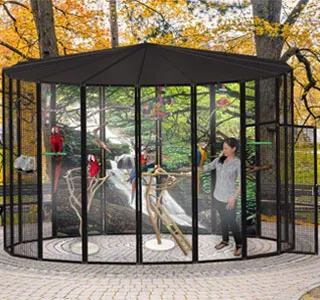Owning a large bird like a parrot, cockatiel, or macaw brings immense joy, but creating the perfect environment is key to their health and happiness. A well-thought-out big bird cage setup ensures your feathered friend has ample space to move, play, and rest comfortably. Whether you’re a new bird owner or upgrading your pet’s home, this guide covers everything from sizing and perches to toys and cleaning routines. Proper setup prevents boredom, stress, and health issues, allowing your bird to thrive.
For popular species like cockatiels, starting with the right food for cockatiel bird alongside a spacious cage makes all the difference in their well-being.
Choosing the Right Size for Your Big Bird Cage
The foundation of any big bird cage setup is size—too small, and your bird will feel confined, leading to behavioral problems like feather plucking or aggression. Traditional pet stores often lack inventory for oversized cages due to space constraints, so sourcing from specialized manufacturers is ideal.
Companies like Custom Cages excel here, offering models like the Suncatcher series in diameters from 3 to 12 feet. Their Hybrid birdcages can reach massive dimensions, such as 72″H x 144″L x 48″D, perfect for multiple large birds. These enclosures feature pull-out trays for effortless debris removal and optional castors for mobility. According to avian experts, a cage should be at least 4 times the bird’s wingspan in width and height to allow natural flight patterns indoors.
 Spacious big bird cage with multiple levels and accessories
Spacious big bird cage with multiple levels and accessories
Investing in a quality large cage not only supports physical health but also mental stimulation. If you’re considering other pet birds, check out options for house birds that fit similar setups.
Essential Perches for Foot Health and Comfort
Varied perches are non-negotiable in a big bird cage setup. Birds in the wild perch on branches of different diameters and textures, which keeps their feet flexible and prevents arthritis or bumblefoot—a common condition in captive birds.
Aim for 3-5 perches per bird, spaced at varying heights to encourage climbing and exercise. Use natural wood branches (untreated and safe species like manzanita or java wood) in diameters from 1/2 inch to 2 inches, matching your bird’s foot size. Avoid uniform plastic dowels, as they promote pressure sores. Position higher perches for sleeping and lower ones near food stations.
For multi-bird households, ensure enough space to avoid territorial fights. Avian veterinarians recommend rotating perches monthly to mimic natural wear. This simple step, backed by organizations like the Association of Avian Veterinarians, significantly boosts joint health.
Engaging Toys to Prevent Boredom
Toys transform a basic big bird cage setup into an enriching habitat. Large birds are intelligent and destructive by nature—they chew to trim beaks, shred for nesting instincts, and manipulate objects for mental workouts.
Select shreddable toys from paper, cardboard, or sisal; foraging toys with hidden treats; and chewable items like wooden blocks or palm leaf balls. Bells are a favorite, as birds love grasping the clapper and the sound mimics wild calls—some even perch them on their heads playfully!
Rotate toys weekly to maintain interest, providing 4-6 options at once without overcrowding. Safety first: Inspect for loose strings or small parts that could cause entanglement or ingestion. Studies from parrot rescue centers show enriched environments reduce screaming and self-mutilation by up to 70%.
If you’re expanding your flock with talkative species, explore cheap talking birds and pair them with durable toys.
How to Clean Your Big Bird Cage Effectively
Hygiene is critical in any big bird cage setup—dirty enclosures breed bacteria, leading to respiratory infections or psittacosis. Weekly wipe-downs with mild, non-toxic soap (like Dawn dish soap diluted in water) and monthly deep cleans keep things pristine.
Disinfect perches, dishes, and toys with avian-safe solutions like F10SC veterinary disinfectant. Custom Cages’ designs shine here: Pull-out trays and floors allow quick liner changes and access to corners without disassembly. Line trays with newspaper or corn cob bedding for easy disposal.
Daily spot-cleaning droppings prevents ammonia buildup, which irritates eyes and sinuses. For budgies or similar, quality budgie food minimizes mess. Pro tip: Wear gloves and ventilate during cleans to protect your health too.
Why Custom Cages Stand Out
Custom Cages prioritizes innovation and craftsmanship, hand-building each unit with over 50 skilled staff and 30,000 sq ft of advanced facilities. Their big bird cage options extend to finches, canaries, lovebirds, and even reptile cages—all with user-friendly features.
Ready to upgrade? Whether buying a buy cockatiel or outfitting its home, their custom approach ensures longevity.
In summary, a stellar big bird cage setup revolves around ample space, diverse perches, stimulating toys, and easy maintenance. These elements promote physical health, mental enrichment, and longevity—large birds can live 50+ years with proper care. Consult an avian vet for species-specific advice, and invest in quality from the start. Your bird will reward you with years of companionship.
References:
- Association of Avian Veterinarians (aav.org) – Guidelines on captive bird housing.
- Custom Cages product specifications (customcages.com).
